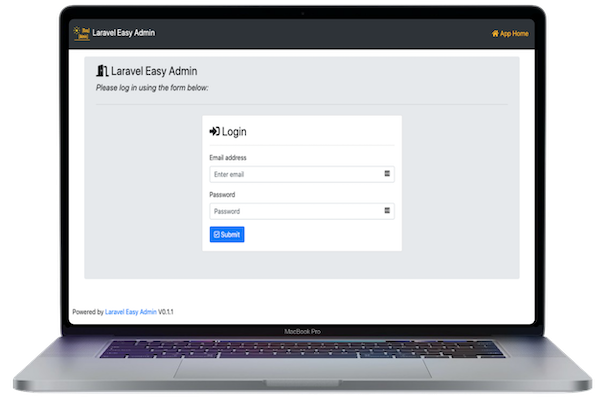- To Be Determined.
composer require devs_ryan/laravel-easy-adminphp artisan vendor:publish --tag="public" --provider="DevsRyan\LaravelEasyAdmin\LaravelEasyAdminServiceProvider"php artisan migrate(Your app is assumed to have a users table at this point)- Access from http(s)://your-project-url.com/easy-admin
The following optional URL variables can be set in the Laravel .env file:
APP_URL(provides a link back to your app on the login page nav bar)EASY_ADMIN_APP_NAME(Change the name shown in the top left of the Easy Admin nav bar)EASY_ADMIN_SUPPORT_EMAIL(Provide a help email address to your Easy Admin users)EASY_ADMIN_DEFAULT_NAMESPACE(Set true to user namespace App\Models)EASY_ADMIN_DEFAULT_PASSWORD(This password will be set for any fields matchingpasswordduring seed generation. Default issecret)EASY_ADMIN_BASE_URL(Change the base URL for your admin area. Default is `easy-admin)
php artisan easy-admin:create-user- Follow the prompts to create a new user account with Easy Admin access
php artisan easy-admin:remove-user- Follow the prompts to remove a user from the database
php artisan easy-admin:user- Enter a user_id or email to grant access
php artisan easy-admin:user --remove- Enter a user_id or email to remove access
After running this command a CRUD resource will be added to the Easy Admin UI for the model specified.
php artisan easy-admin:add-model- Follow the prompts for namespace E.G. "App" and model name E.G. "User"
- This will generate a new file in the base projects app/EasyAdmin directory, where you can comment out any functionality you do not wish to provide to the Easy Admin UI
php artisan easy-admin:remove-model- Follow the prompts for namespace E.G. "App" and model name E.G. "User"
- This will remove the model from showing in the UI and delete the app/EasyAdmin file for it as well
php artisan easy-admin:refresh-model- Follow the prompts for namespace E.G. "App" and model name E.G. "User"
- This will reload the public file in the app/EasyAdmin directory to the default and load/remove any fields that have changed in the model
Add all models within a given namespace to Easy Admin
In case you would like to return Easy Admin to the original state, use the command below.
php artisan easy-admin:reset
Lists the supported image sizes that are generated when uploading an image file.
php artisan easy-admin:image-sizes
Used to retrieve an image that was created using Easy Admin (see size options using command above)
easyImg($model_name, $field_name, $file_name, $size = 'original')
Used to retrieve an image that was created using Easy Admin (with full image details, does not work with general storage)
easyImgDetails($model_name, $field_name, $file_name)- Note: $field_name argument can be set to
nullorgeneral_storagefor WYSIWYG related images
Used to retrieve a file that was created using Easy Admin
easyFile($model_name, $field_name, $file_name)
Used to strip any HTML away from text for wysiwyg fields
easySafeText($blog_post->content)
This admin panel assumes that you follow the standard Laravel naming conventions for models and database tables. If you create migrations/models using php artisan make:model {ModelName} -m it should work, otherwise it may not.
The users table is expected to contain some fields that ship with the Laravel base install, such as email and password.
All model resources must contain and id attribute in their database table for the routing to function.
Laravel Easy Admin is open-sourced software licensed under the GNU Lesser General Public License v3.0.




